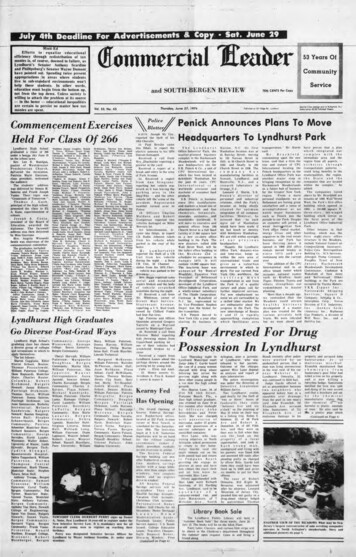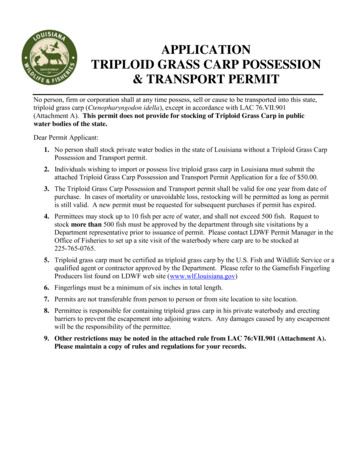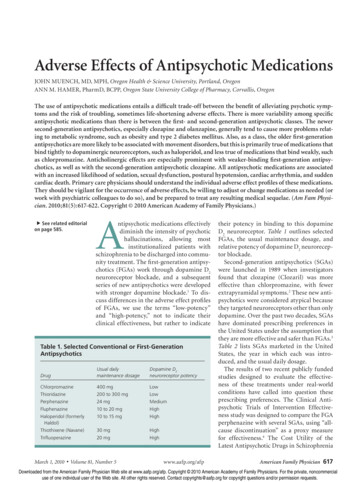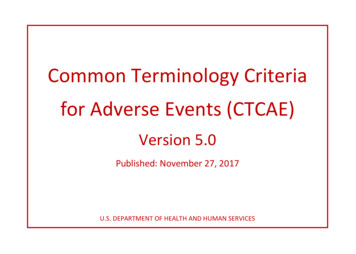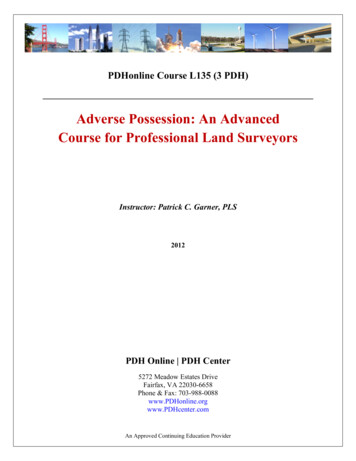
Transcription
PDHonline Course L135 (3 PDH)Adverse Possession: An AdvancedCourse for Professional Land SurveyorsInstructor: Patrick C. Garner, PLS2012PDH Online PDH Center5272 Meadow Estates DriveFairfax, VA 22030-6658Phone & Fax: 703-988-0088www.PDHonline.orgwww.PDHcenter.comAn Approved Continuing Education Provider
www.PDHcenter.comPDH Course L135www.PDHonline.orgADVERSE POSSESSIONAn Advanced Course for Professional Land SurveyorsPatrick C. Garner, PLSCourse ContentAdvanced Course IntroductionAdverse possession is a legally recognized way, or method, of taking title to property by physicaloccupation. It is always a hostile act. Based on ancient principles of common law, adversepossession is defined by statute on a state-by-state basis. In all states, possession must run for astatutory period, and the adverse claimant is charged with the burden of proof.Boundary surveyors must be familiar with this doctrine, as retracement surveys are frequentlycomplicated by claims of adverse possession. A survey of original property lines cannot, byitself, revive the rights to land lost in adverse possession. Understanding the elements of adverserights--with an awareness that variations exist between state laws--is critical. The appearance ofsurveyors in court is often triggered by issues of adverse possession, with attorneys relyingheavily on surveyors as experts in what is often a difficult legal doctrine.Adverse Possession: An Advanced Course for Professional Land Surveyors, is a three-hourcourse that reviews the historic concepts of adverse possession, the statutory character of theseactions, and the burden of proof against the claimant. This course examines the effect of surveyson such claims, exemptions to claims of adverse possession, and the well established elements ofadverse possession. The course also discusses the doctrine of prescription and its relationship toadverse possession. Using various examples both from classic texts and the author’s experiences,the course examines statutes of limitations, color of title, and a surveyor’s explicit duties toclients and courts.Legal DefinitionsBlack’s Law Dictionary defines adverse possession as, “A method of acquisition of title to realproperty by possession for a statutory period under certain conditions.” It goes on to note, “Inorder to establish title in this manner, there must be proof of nonpermissive use which is actual,open, notorious, exclusive and adverse for the statutorily prescribed period.”Black’s further notes, “State statutes. differ with respect to the required length of possessionfrom an upper limit of 20 years to a lower one of 5 years, with even more extreme time periodscovering certain special cases. There may be different periods of time even within a single state,depending on whether or not the adverse possessor has color of title.” (Note that color of titleoccurs when there is the appearance of holding good title, when in reality, some defect preventsclear title.)Black’s concludes that, “There may also be different periods of time even within a single state,Page 1 of 20
www.PDHcenter.comPDH Course L135www.PDHonline.orgwhether or not taxes have been paid. In some cases a longer possession is required against publicentities than against individuals.”Curtis Brown et al, in Boundary Control and Legal Principles, states, “Adverse Possession isdefined by possession of another’s land which when accompanied by certain acts andcircumstances will vest title in the possessor. There must be actual possession. The possessionmust be open and notorious, hostile and continuous in the occupant or those claiming under himfor the period prescribed by statute.”Madson in Rhode Island Property Boundary Law states, “Although color of title is not essential,it is of great evidentiary value. Adverse possession depends on the intent of the occupant toclaim and hold real property in opposition to all the world and also embodies the idea that theowner of, or persons interested in, property have knowledge of the assertion of ownership by theoccupant. Payment of taxes alone is not sufficient to establish adverse possession. It ismandatory that the element of continuous possession be for the full statutory period.”Davis, Foote and Kelly, in Surveying: Theory & Practice, define adverse possession as, “Theenjoyment of land, under such circumstances as indicate that such enjoyment has beencommenced and continued under an assertion of right on the part of the possessor.”All of these definitions mirror each other in requiring the following elements: Occupation for the full statutory period. Actual physical occupation. Open--and notorious--occupation. Exclusive and adverse occupation for the statutorily prescribed period.Prescription, and Prescriptive EasementsUnlike adverse possession--which is a way of taking title to property by physical occupation-prescription is defined as a method of obtaining easement rights as a result of long use.Prescription coveys only a right of usage, and is commonly confused with adverse possession.This separate doctrine will be examined in more detail later in the course.Historic Concepts of Adverse PossessionThe American doctrine (a doctrine is a stated principle of government policy) of adversepossession evolved from Roman Common Law, from English Common Law, and later, fromsettlement of the North American continent. Greeks and Romans believed that a person’s spiritbecame a part of land that was settled, so in effect, the person who lived on a parcel became, in areal sense, part of the land. Thus, by logic, law and decree, that person became the owner.Conflicting with this initial heritage, English Common Law favored the title holder of property,reflecting a historic bias in favor of titled land owners who, as the policy evolved, werepredominately lords and barons. The bias between these different cultures may have also resultedfrom differences in available land mass. In Greek and Roman settlements, land seemed almostlimitless, whereas in England, land was defined by the limits of the island itself.Page 2 of 20
www.PDHcenter.comPDH Course L135www.PDHonline.orgNevertheless, much of English Common Law is based on precepts and fundamental legalprinciples handed down from early Roman law. Thus, in the merger of these two concepts-Roman and English Common Law--arose a new doctrine that recognized the right of a person to“occupy a parcel of land under certain adverse conditions, and to obtain a new written title inaccordance with the statutes of a given jurisdiction.” (Brown, Boundary Control)English Common Law has in the last 200 years been further modified and defined by numerousstatutes and court decisions in the United States. Regardless, the doctrine of adverse possessionstrongly reflects the basic principles crafted in England before America was settled.Of note, in the United States, where title to property is held under a Torrens title (also called landregistration or land court title), adverse rights cannot be advanced. Although not common, at thisdate, twenty states have passed land registration systems. Those states are California, Colorado,Georgia, Hawaii, Illinois, Massachusetts, Minnesota, Mississippi, Nebraska, New York, NorthDakota, Ohio, Oregon, South Carolina, South Dakota, Tennessee, Utah, Virginia andWashington. In 1958 California repealed its act for lack of use. Even in states with Torrens titles,the majority of real property is not held under such title. When investigating claims of adversepossession, the surveyor must be aware of whether a given parcel is effected by such registration.Barbed wire recently restrung on ancient fence posts. The fence exists ten feetinto an adjoining property. Adverse possession or a permissive use?Elements of Adverse PossessionWhile examining the statutory character of adverse actions, we will review ten basic elementscommon to this doctrine. The legal presumption is that a claim will “ripen” into clear title (orfee) when all or most of the following elements are met. (Note that these elements vary fromstate to state, particularly in emphasis, and that all ten are not required in every state.)Some legal scholars have noted that adverse possession is essentially a punishment against anowner for negligence. As harsh as this appears, the conclusion makes sense; for someone toadversely possess another’s land, the owner has, in effect, abandoned it. However, courts stillview adverse possession as what it is--theft. An owner therefore does not have to be negligent fora short time, but, because laws aspire to fairness, must be negligent for years. An owner does nothave to fear losing his land when he leases or rents it to another party, nor does he have to worryabout loss when he shares it with others. The bar is high for adverse claims, and the statutoryelements have been tested and refined from centuries of adjudication.Page 3 of 20
www.PDHcenter.comPDH Course L135www.PDHonline.orgUnderstanding the following elements of adverse possession is critical.1.Actual possession.2.Open and notorious possession.3.Claim of title.4.Continuous possession.5.Hostile possession.6.Exclusive possession.7.Possession for a statutorily defined period (also called a statute of limitations).8.Color of title in some states.9.Paid taxes in some states, and10. Good faith in some states.Of these ten elements, five are considered fundamental. The five, recognized by all states andjurisdictions, are: Actual possession; Open and notorious possession; Continuous possession;Hostile possession; and Possession for a statutorily defined period.Of the elements, the time period for meeting the definition of continuous possession variesgreatly (see expanded discussion below). Becoming familiar with the specific requirements foradverse possession in your own state is critical. As Brown notes in Boundary Control, “Sincethere is no merit in awarding the adverse claimant land flinched by legal means, the courtsusually insist on strict adherence to the requirements of a given state.” An examination of each ofthe ten elements follows.Actual PossessionActual possession requires obvious, physical use of the claimed property. That use may includefencing, farming, construction of buildings, land clearing (followed by some other sign of furtherpossession), and similar improvements or visible changes to the property.An element of this requirement occurs when the claimant denies access to the rightful owner orhis agents. Years ago when I was conducting a survey in Savannah, Georgia, a man suddenlyappeared from behind a tree and pointed a shotgun at me. “You’re on my land,“ he said. “Get offor you’re dead.“ Without saying enough to get myself shot, I offered excuses, raised my hands,and backed away as quickly as I could. His statement clearly established his claim to the land,and denied me access. At the time I was not an expert in adverse possession, and immediatelycalled my client. His attorney concluded rather too quickly--I realize in retrospect--that the man’sdeclaration was insufficient to sustain a claim of adverse possession, and asked me to completethe work. I was young and foolish, and returned to finish the boundary a week later. Much to myrelief, the man did not reappear. Regardless, if he had, and if he had attempted to establish otherelements of an adverse claim, he may have been able to sustain his claim.Page 4 of 20
www.PDHcenter.comPDH Course L135www.PDHonline.orgNote that a survey of the land by itself cannot establish actual possession. As Ray Skelton statesin Boundaries and Adjacent Properties, “Actual possession is not established by entering land,surveying the same, and fixing the boundaries thereof, even when accompanied by theestablishment of monuments.” Yet in an Iowa court decision, it was considered sufficient whenthe owner of a small parcel had a survey made to include adjacent property to his own and hadmonuments set. In addition, he had pointed out the land as his own, and maintained it regularly(Whalen v Smith, 183 Iowa 949, 167 N.W. 646). In this court decision, additional elements cameinto play, including the owner’s constant maintenance of the adjoining land, and his claim toother parties that he was the owner.Surveying alone is not sufficient to put an owner on notice because monuments may not beobvious, and signs of a survey quickly disappear. In an Illinois case (White v Harris, 206 Ill.584), the court ruled, “The survey of unenclosed land, and the placing of stones at the boundarycorners, is not such a taking of possession as is contemplated by section 7 of the limitations act.”Consequently, fencing is the most common form of recognized possession, and in fact, isrequired as an element in some jurisdictions. Fencing is also the most common form of“possession” that a professional land surveyor encounters. Substantial fences give what is calledconstructive notice to an owner of adverse possession, and meet the requirement for “open andnotorious.” Note that fencing must be substantial, which in certain jurisdictions is legallydefined. Typically, fences must be set as boundaries for the purpose of defining claimed land.Scattered posts set at random intervals along a line might not meet this requirement; a five-foothigh wood fence clearly would.An unusually strong-worded court decision states, “By actual possession is meant a subjection tothe will and dominion of the claimant, and is usually evidenced by occupation--by a substantialenclosure--by cultivation, or by appropriate use, accordingly to the particular locality and qualityof the property.” (Coryell v Cain, 16 Calif. 567)Intermittent farming of a property is not, by itself, sufficient to meet statutory requirements.Similarly, timbering a site not owned by the woodsman is considered theft, and not a claim ofpossession. On the other hand, continuous cultivation of a property within defined areas for aperiod sufficient to meet statutory periods might suffice.Open and N
www.PDHonline.org www.PDHcenter.com An Approved Continuing Education Provider. www.PDHcenter.com PDH Course L135 www.PDHonline.org Page 1 of 20 ADVERSE POSSESSION An Advanced Course for Professional Land Surveyors Patrick C. Garner, PLS Course Content Advanced Course Introduction Adverse possession is a legally recognized way, or method, of taking title to
